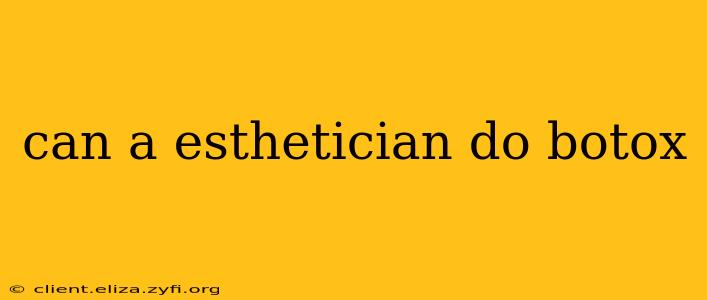Can an Esthetician Do Botox?
The short answer is: no, generally not. While estheticians are skincare professionals with expertise in skin health and treatments, administering Botox injections is strictly regulated and requires a different license and extensive medical training. This crucial distinction protects patient safety and ensures the procedure is performed correctly.
Let's delve deeper into why this is the case and explore some related questions.
What is the Difference Between an Esthetician and a Medical Professional Qualified to Administer Botox?
Estheticians focus on the external aspects of skincare. Their training covers topics like skin analysis, facials, chemical peels, microdermabrasion, and other non-invasive treatments. They are skilled in improving the skin's overall appearance and health through topical applications and techniques.
Conversely, medical professionals authorized to administer Botox, such as dermatologists, plastic surgeons, and some nurse practitioners or physician assistants, possess extensive medical training, including anatomy, physiology, and pharmacology. They undergo rigorous education and certification to safely and effectively inject botulinum toxin (Botox). This includes understanding potential risks, complications, and how to manage them. Their knowledge extends beyond the skin's surface to encompass the underlying structures and potential systemic effects of the injection.
What Training and Licensing is Required to Administer Botox Injections?
The requirements to administer Botox vary slightly by location, but generally, only licensed medical professionals can legally do so. This often means a medical degree, specialized training in injectables, and ongoing continuing education to maintain their license and stay abreast of best practices and safety guidelines. Attempting to perform Botox injections without the proper credentials is illegal and potentially dangerous.
Why is it Illegal for an Esthetician to Administer Botox?
The primary reason is patient safety. Botox injections are a medical procedure, and improper administration can lead to serious complications, including:
- Nerve damage: Incorrect injection can paralyze unintended muscles, leading to temporary or permanent weakness or drooping.
- Allergic reactions: While rare, allergic reactions to Botox are possible, requiring immediate medical attention.
- Infection: Improper injection techniques can introduce infection.
- Uneven results: Lack of medical training can result in uneven application, leading to an unsatisfactory cosmetic outcome.
These are just a few examples; the risks of untrained individuals administering Botox are significant. Legal restrictions prevent untrained individuals from performing medical procedures to ensure public safety.
What Skincare Treatments Can an Esthetician Perform?
Although estheticians cannot administer Botox, they offer a wide range of valuable skincare services that complement Botox treatments, including:
- Facials: Customized facials address specific skin concerns like dryness, acne, or aging.
- Chemical peels: These exfoliate the skin, improving texture and tone.
- Microdermabrasion: This technique uses tiny crystals to remove dead skin cells.
- Microneedling: This treatment stimulates collagen production for improved skin texture and reduces the appearance of fine lines and wrinkles.
Where Can I Get Safe and Effective Botox Treatments?
For safe and effective Botox treatments, consult a board-certified dermatologist, plastic surgeon, or another qualified medical professional. Research their credentials, experience, and read patient reviews before scheduling your appointment. Choosing a qualified practitioner significantly reduces the risk of complications and ensures you receive the best possible results.
In conclusion, while estheticians provide valuable skincare services, Botox administration is a medical procedure requiring specialized training and licensing. Always choose a qualified medical professional for Botox injections to prioritize your safety and achieve optimal results.
